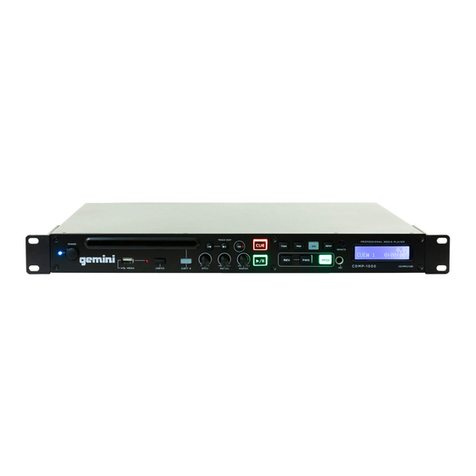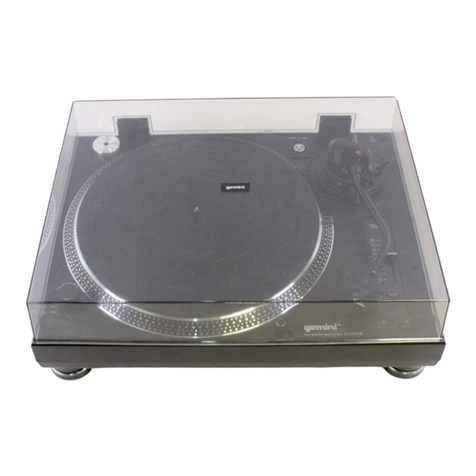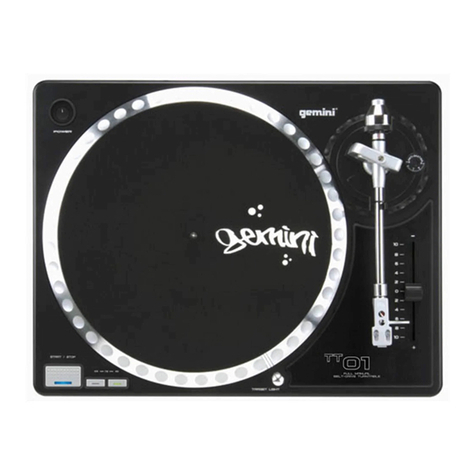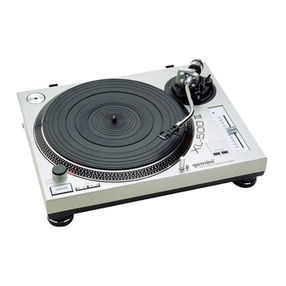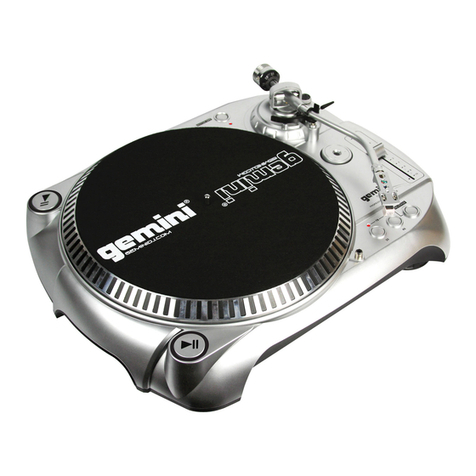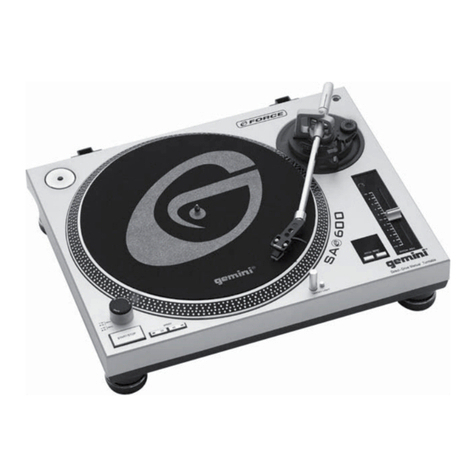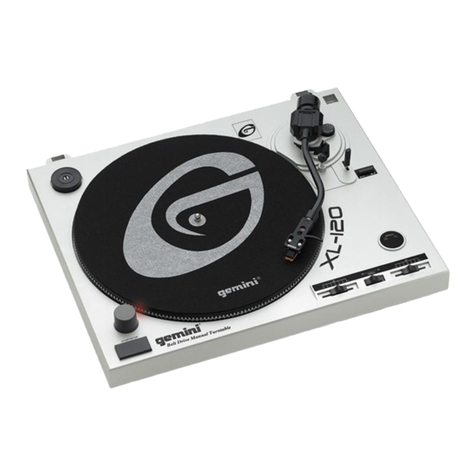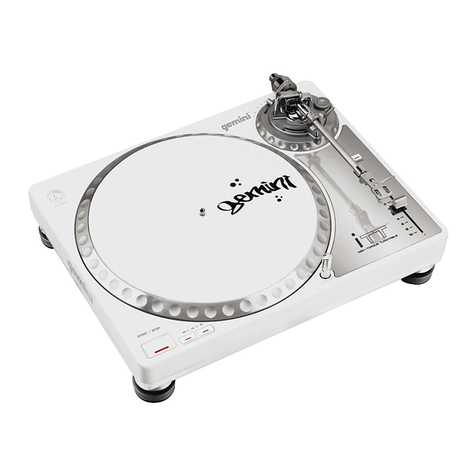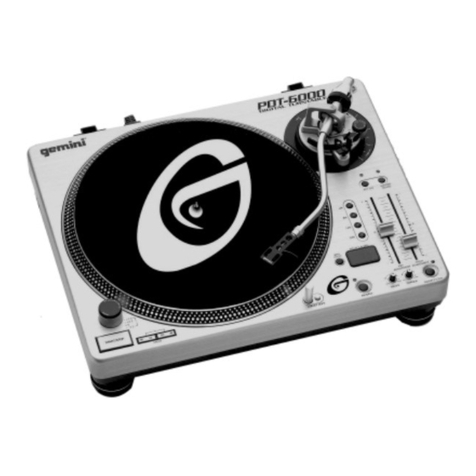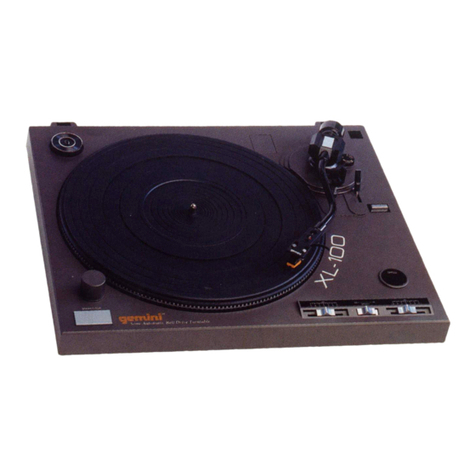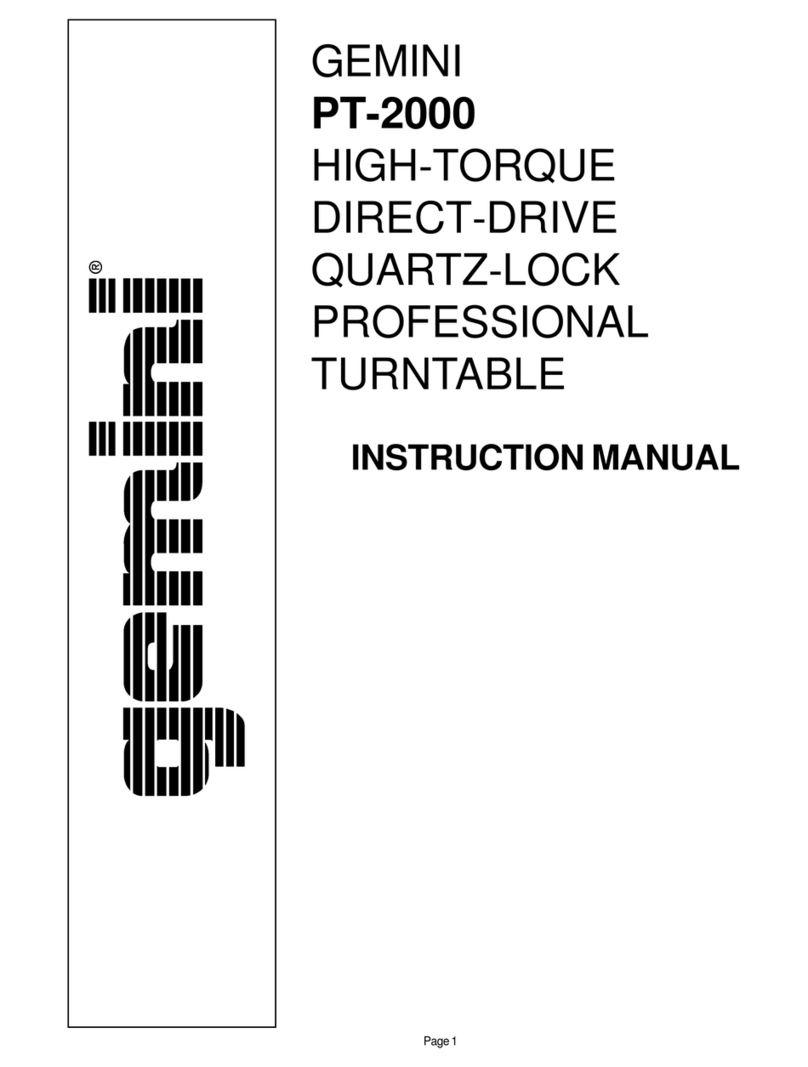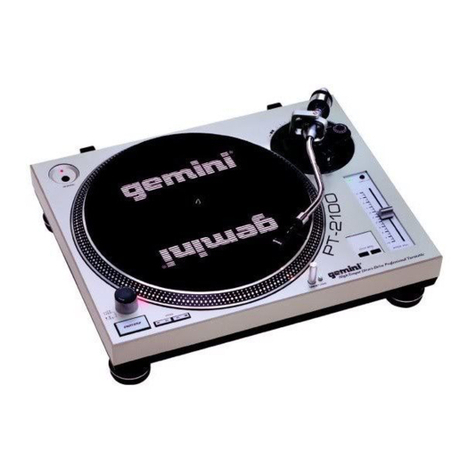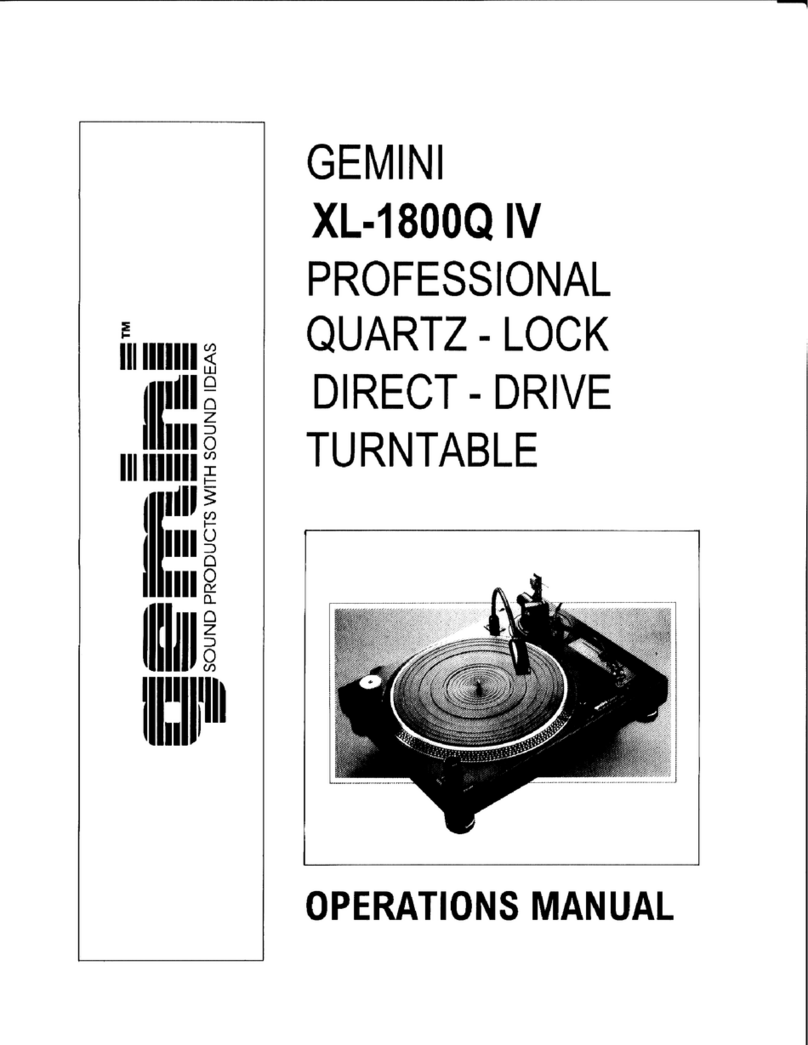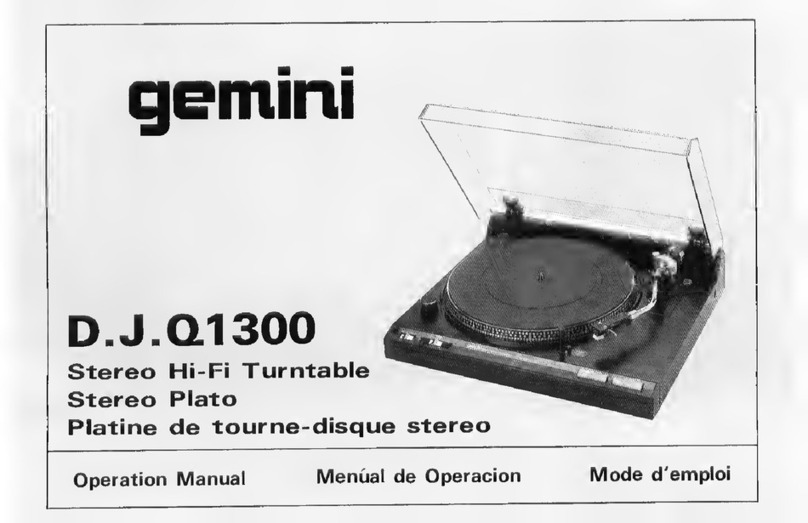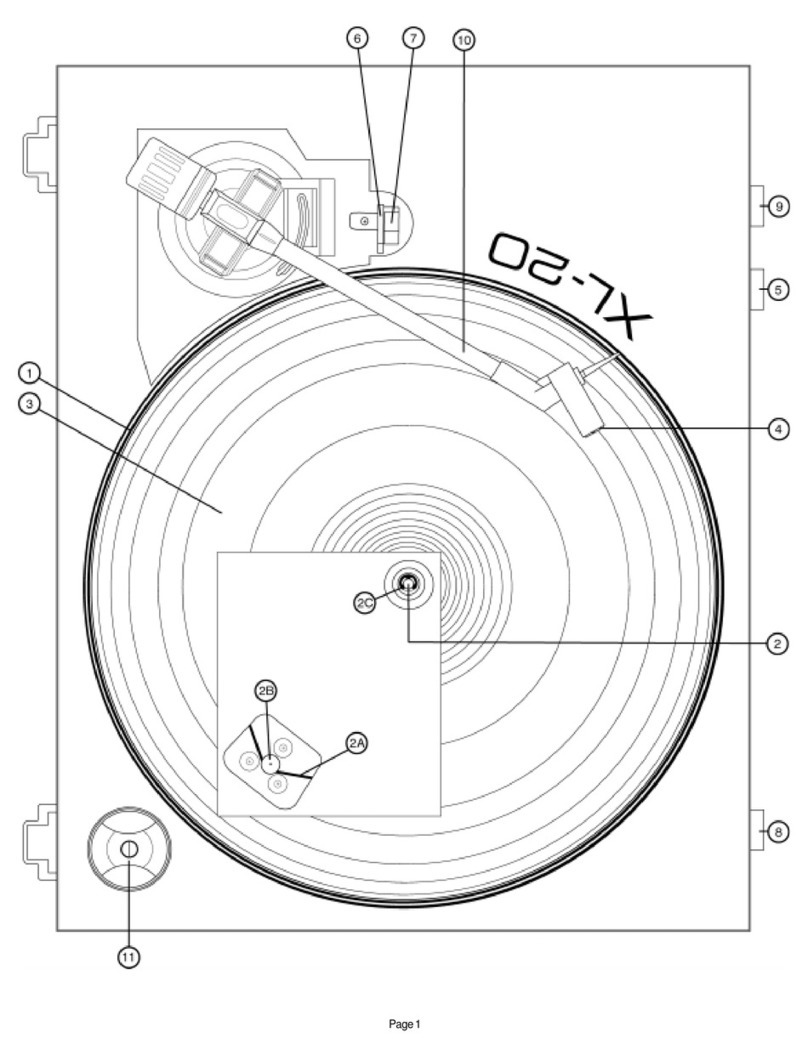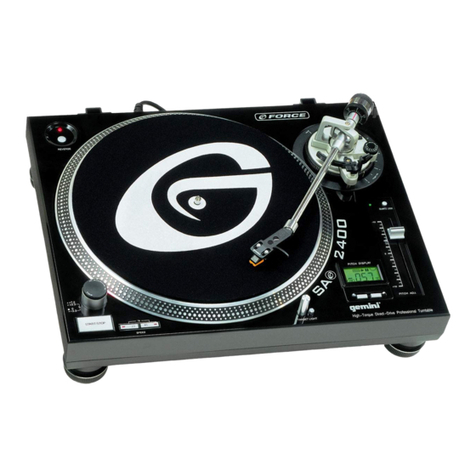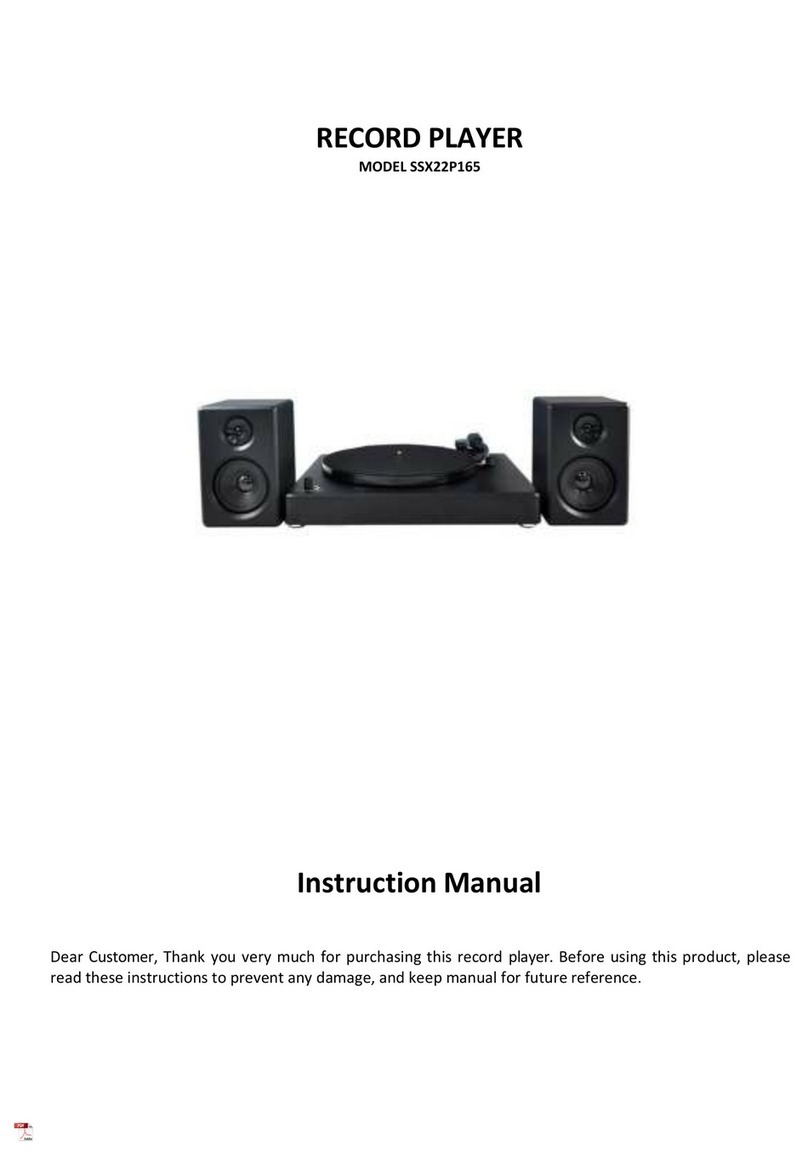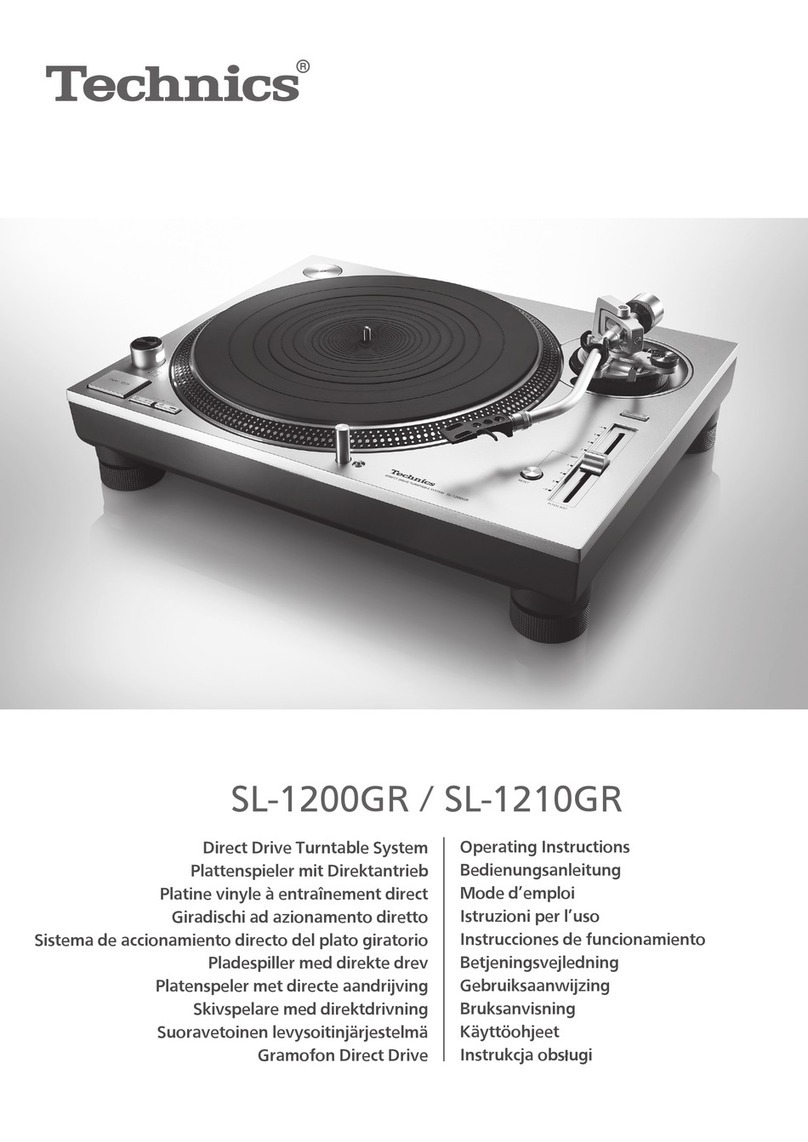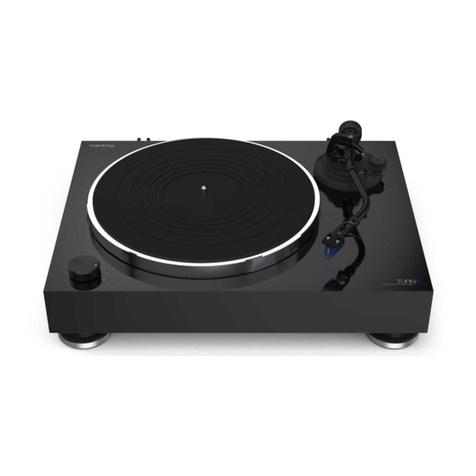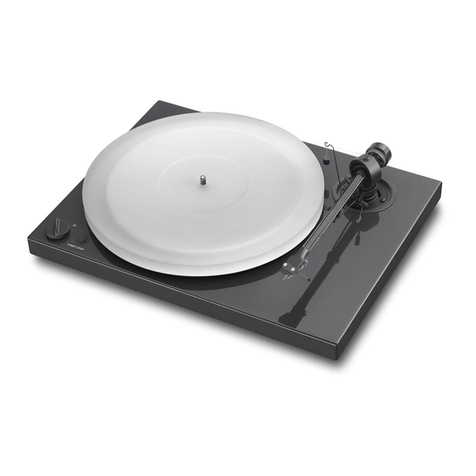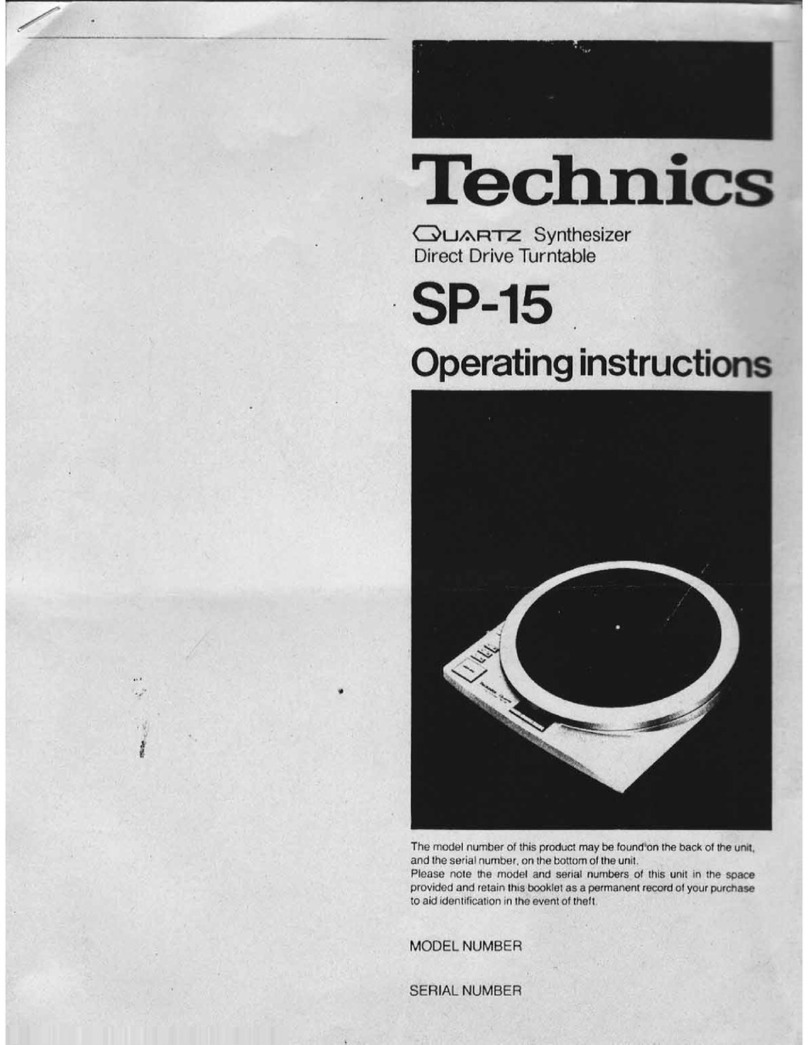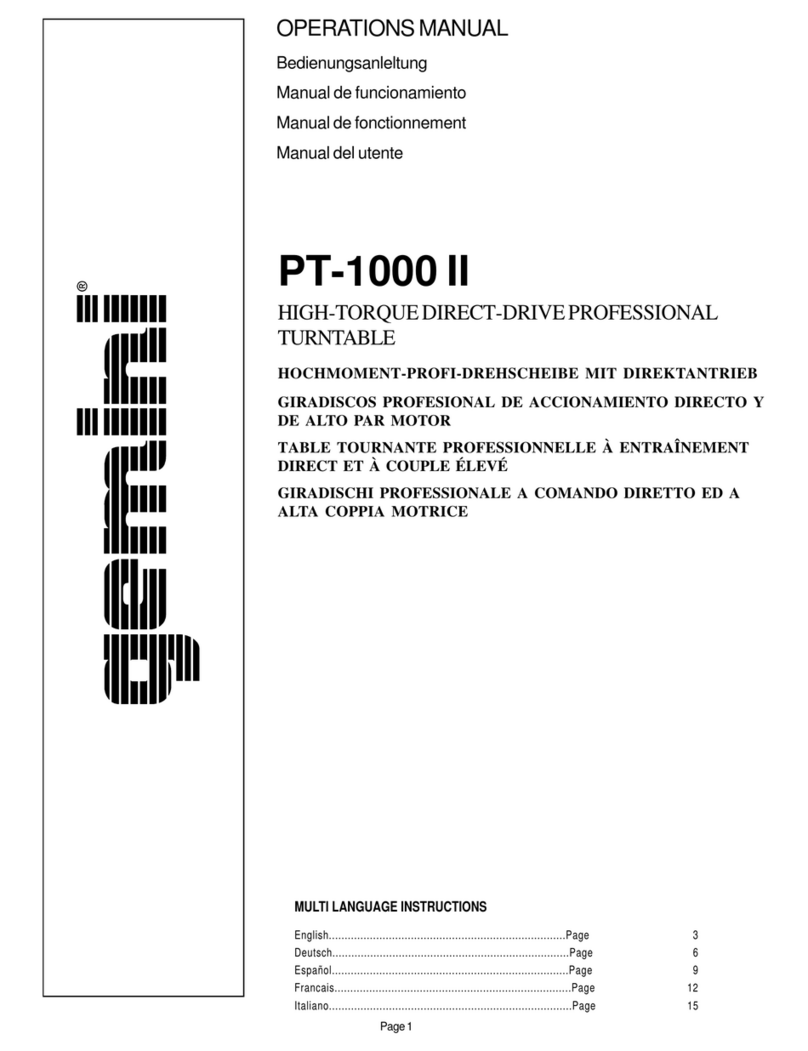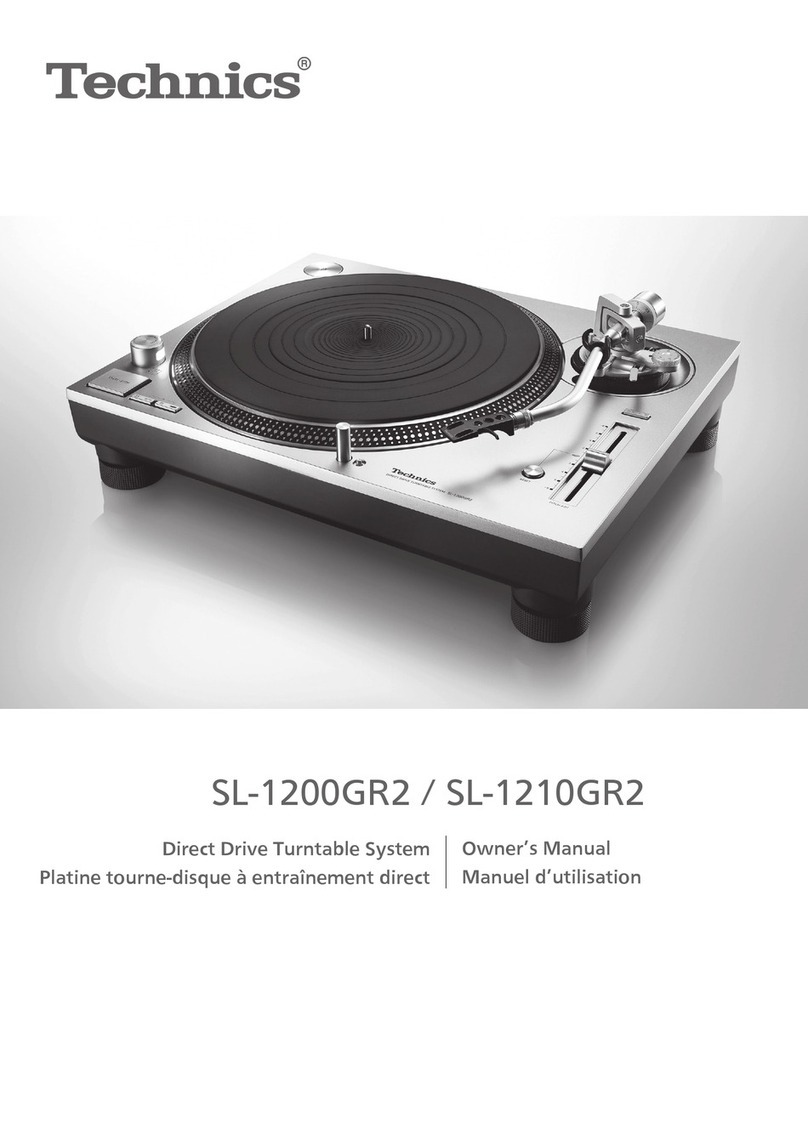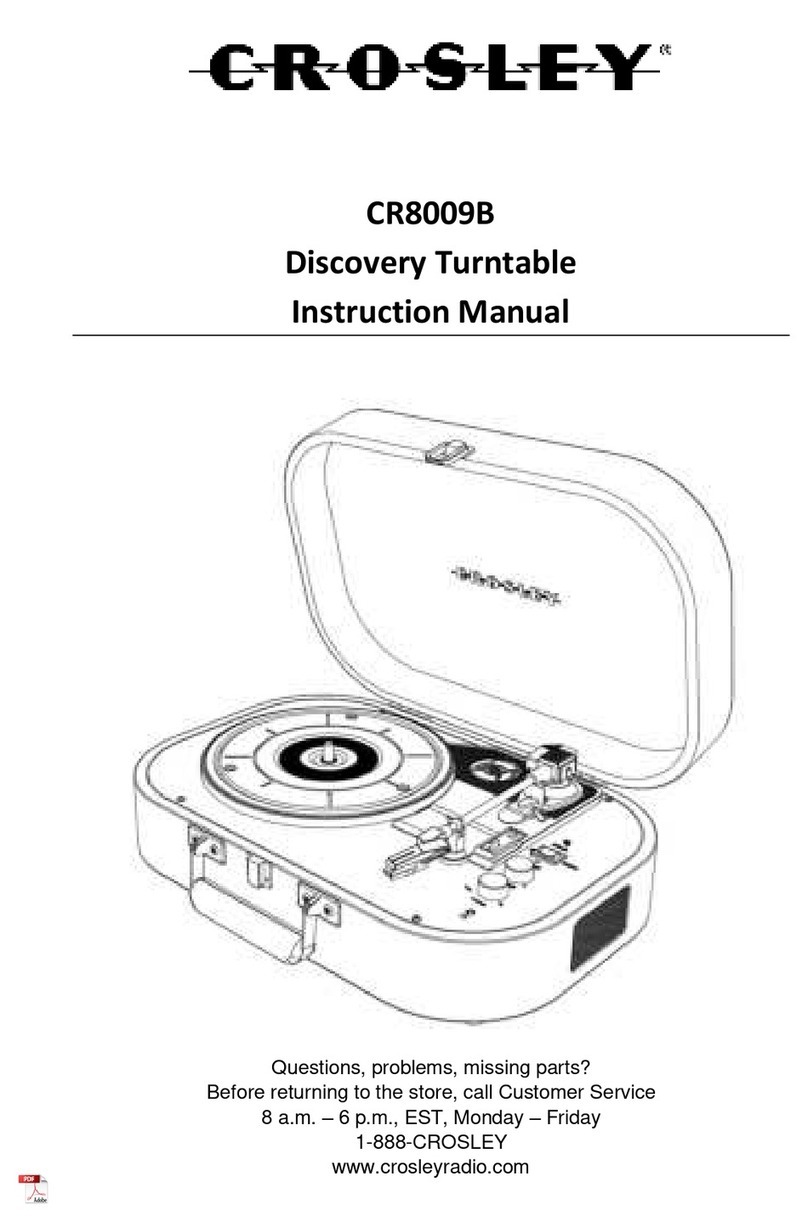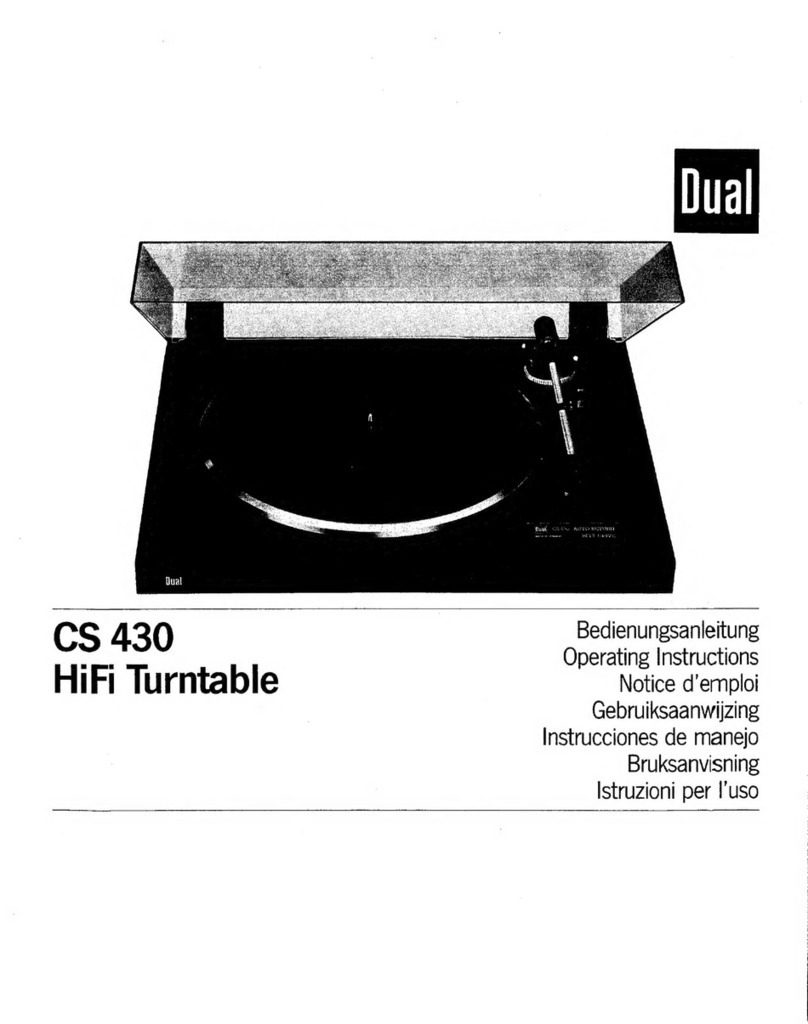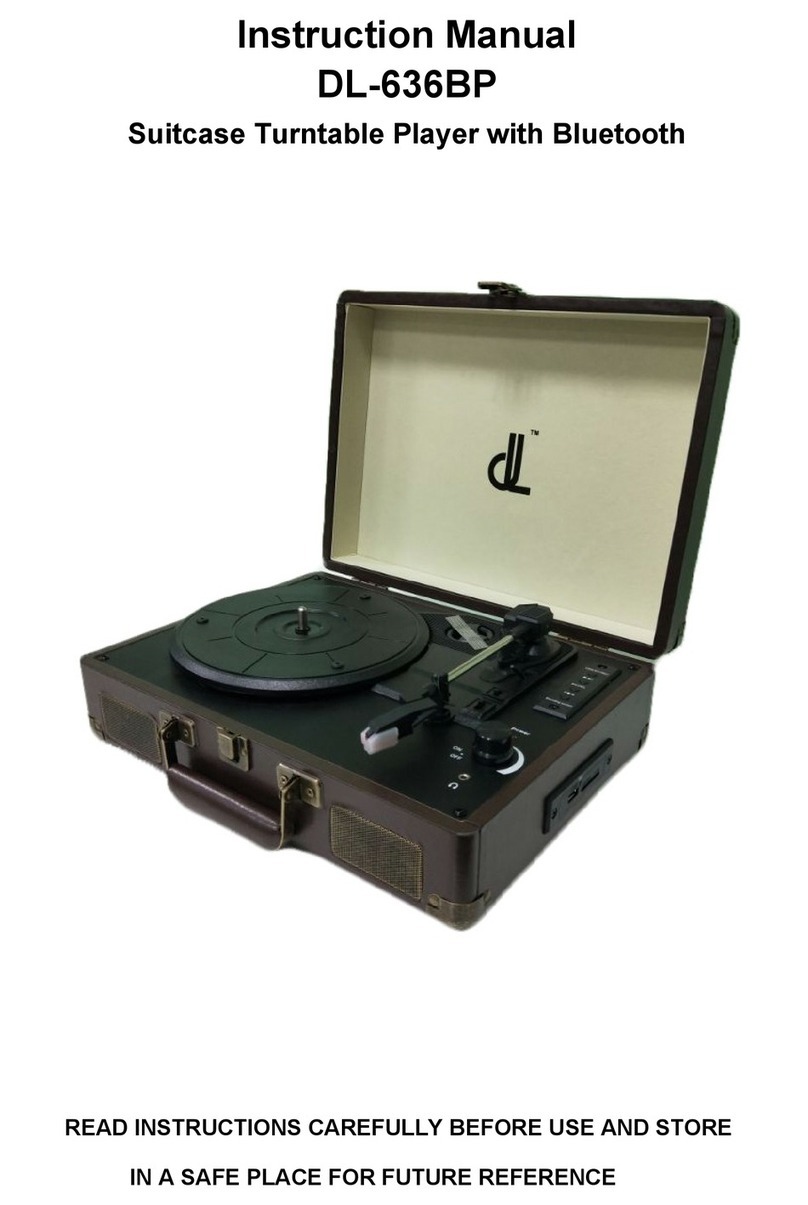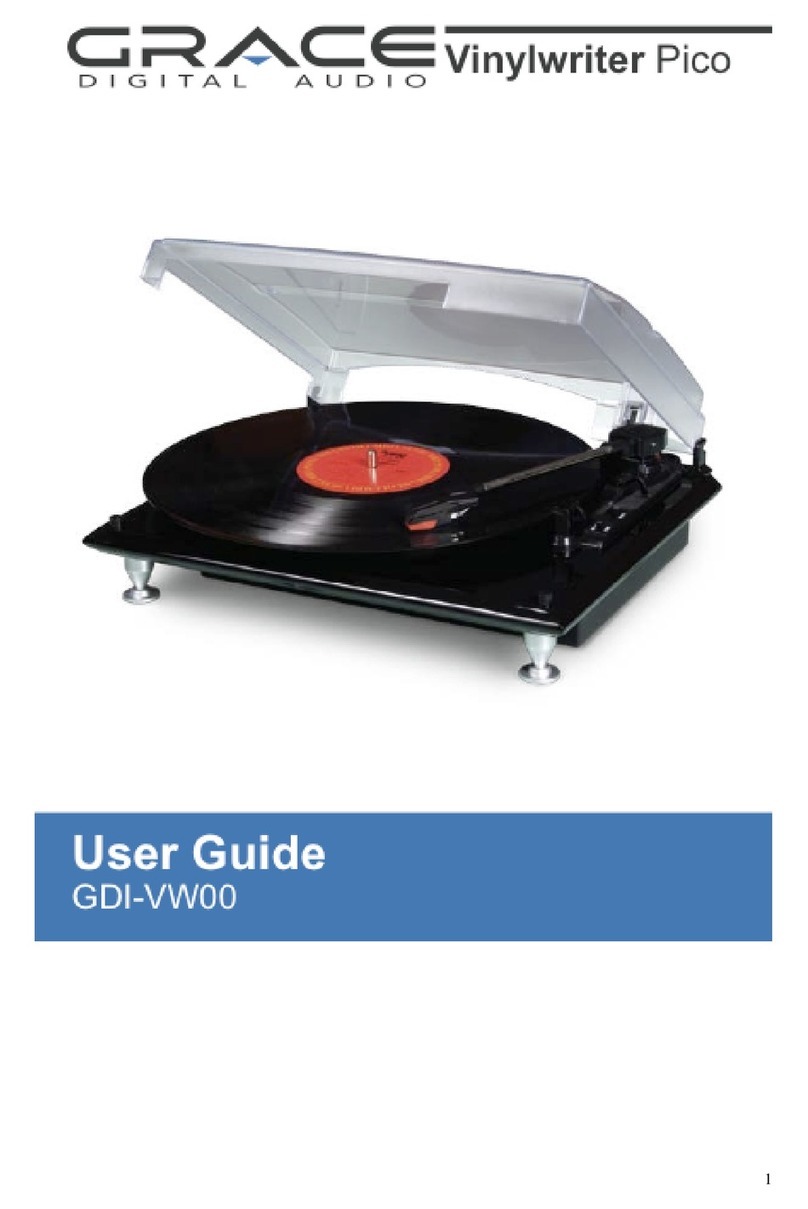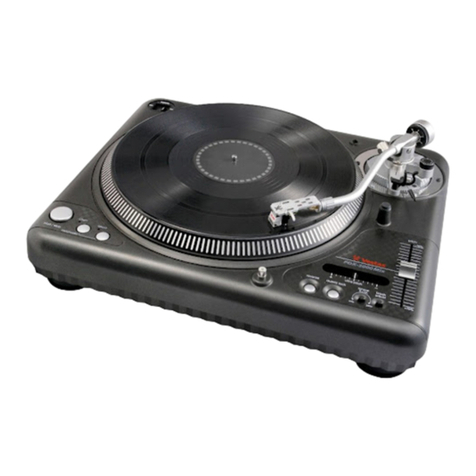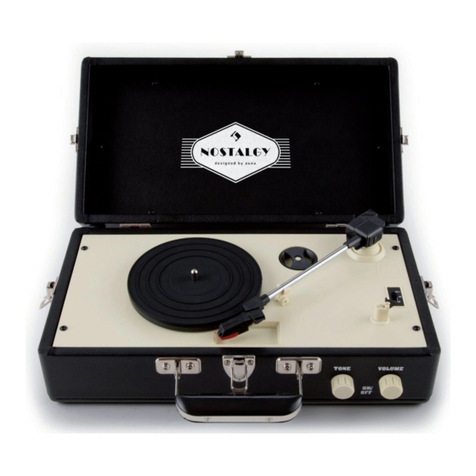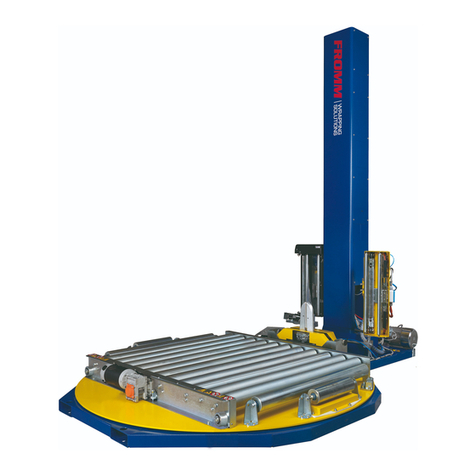
Page 8
Introducción
Felicitaciones por su compra de un tocadiscos Gemini XL-400 II. Este
tocadiscos de la más avanzada tecnología está dotado de características
ultramodernas. Antes de usarlo, le recomendamos leer cuidadosamente
todas las instrucciones.
Características
• Regulación del tono de ±10% • Iluminador estroboscópico
• Interruptor táctil de arranque/parada
Precauciones
1. Deberán leerse todas las instrucciones de operación antes de usar el
equipo.
2. Para reducir el riesgo de shock eléctrico, no abra la unidad. NO
CONTIENE PIEZAS REEMPLAZABLES POR EL USUARIO. Sírvase
comunicarse con el Departamento de Servicio Gemini o su distribuidor
autorizado y hablar con un técnico de servicio calificado.
3. Los cojinetes del brazo de fonocaptor están ajustados y sellados en
fábrica. Cualquier intento de ajuste dejará sin efecto la garantía.
4. Cerciórese de que toda la corriente CA esté APAGADA para efectuar
las conexiones.
5. Los cables deberán ser de baja capacidad, reguardados, y de
apropiado longitud. Cerciórese de que todos los enchufes y jacks estén
apretados y debidamente conectados.
6. Comience siempre con los atenuadores de nivel de audio/control de
volumen fijados en el nivel mínimo y el control de volumen de los
altoparlantes fijados en APAGADO. Espere 8 a 10 segundos antes de
aumentar el volumen de los altoparlantes para evitar el “chasquido”
transitorio que podría ocasionar daños a los altoparlantes/de cruce.
7. No deje esta unidad expuesta a lluvia o humedad.
8. No use ningun limpiador de rocío o lubricante en cuaquiera de los
controles o interruptores.
Lista de comprobación de piezas
Unidad de tocadisco.....................................................................1
Plato del tocadisco........................................................................1
Estera de goma ............................................................................1
Tapa contra polvo.......................................................................1
Bisagra de tapa contra polvo........................................................2
Adaptador de 45 RPM.....................................................................1
Contrapeso...................................................................................1
Portafonocaptor...............................................................................1
Montaje y configuración
NOTA: VÉASE LA FIG. 1 (PÁGINA 1) PARA NÚMEROS DE PIEZA Y
UBICACIONES.
INSTALACIÓN DEL TOCADISCO:
1. Ponga la BASE DEL TOCADISCO - TURNTABLE BASE (1) sobre una
superficie plana y nivelada sin vibraciones. Trate de colocar la unidad lo
mas alejado posible de los altoparlantes. Mantenga la unidad alejada
de la exposición directa del Sol, calor, humedad o suciedad. Mantenga
la unidad bien ventilada. Use la patas del tocadisco para estabilizar la
unidad en sentido horizontal.
2. Cerciórese de que el SELECTOR DE VOLTAJE - VOLTAGE SELEC-
TOR (3) (colocado en la BASE DEL TOCADISCO) esté arreglado para
el voltaje correcto. ADVERTENCIA: Si trata de hacer funcionar el
tocadisco con el voltaje incorrecto, corre el riesgo de dañarlo.
3. Después de comprobar que se hayan quitado todos los materiales de
embalaje, coloque el PLATO - PLATTER (2) suavemente en el huso
central de la BASE DEL TOCADISCO - TURNTABLE BASE (1).
4. La correa está asegurada al fondo del disco del tocadisco pero debe
ser asegurada al eje del motor. Haga girar el disco hasta que se vea el
eje; después ponga los dedos en los orificios en la parte superior del
disco, busque y agarre la correa de caucho y asegúrela al eje del motor.
5. Coloque la ESTERA DE GOMA - RUBBER MAT (4) sobre el PLATO -
PLATTER (2).
INSTALACIÓN DEL CARTUCHO: (VÉASE LA FIG. 2)
Debido a que todos los cartuchos son de diseño distinto, sírvase referirse a
las instrucciones de su cartucho específico, para garantizar la instalación
correcta.
1. Conecte los alambres conductores a los terminales del cartucho. Para
su conveniencia, los terminales de la mayoría de los cartuchos están
codificados por colores. Conecte cada alambre conductor al terminal
del mismo color.
Blanco (I+)..............................Canal izquierdo +
Azul (I-)...................................Canal izquierdo -
Rojo (D+)................................Canal derecho +
Verde (D-)...............................Canal derecho -
2. Monte el cartucho dentro del PORTAFONOCAPTOR - HEADSHELL (5)
y apriételo con los tornillos incluidos con el cartucho.
ATENCIÓN USADORES DE LOS CARTUCHOS STANTON 680
Al usar un cartucho Stanton 680 o cartucho similar, en el cual el cuerpo
se conectado a tierra a un terminal del cartucho, quite la correa de
tierra del cuerpo del cartucho hacia el terminal de tierra del cartucho.
Al no hacer esto puede resultar en zumbido excesivo.
INSTALACIÓN DEL PORTAFONOCAPTOR:
Inserte el PORTAFONOCAPTOR - HEADSHELL (5) en la parte delantera
del BRAZO DE FONOCAPTOR - TONE ARM (6) tubular. Sosteniendo el
PORTAFONOCAPTOR firmemente en posición horizontal, gire la TUERCA
FIADORA - LOCKING NUT (7) hacia la izquierda hasta que el
PORTAFONOCAPTOR se haya asegurado en posición.
INSTALACIÓN DEL CONTRAPESO: (VÉASE LA FIG. 3)
1. Deslice el CONTRAPESO - COUNTERWEIGHT (8) sobre la parte
posterior del BRAZO DEL FONOCAPTOR - TONE ARM (6) con la
medida de la aguja numerada hacia el frente.
2. Gire el CONTRAPESO - COUNTERWEIGHT (8) ligeramente hacia la
izquierda para enroscarlo en la parte posterior del BRAZO DE
FONOCAPTOR - TONE ARM (6).
AJUSTE DEL EQUILIBRIO CERO (0) HORIZONTAL Y
PRESIÓN DE LA AGUJA:
1. Sin tocar la punta de la aguja, quite el protector de aguja (si el de su
cartucho es removible).
2. Suelte el SUJETABRAZO - ARM CLAMP (9) y levante el BRAZO DE
FONOCAPTOR - TONE ARM (6) del DESCANSILLO - ARM REST (10).
3. Si el CONTRAPESO - COUNTERWEIGHT (8) se avanza hacia la
izquierda, se bajará el lado del cartucho del BRAZO DE FONOCAPTOR
- TONE ARM (6). Si el CONTRAPESO se avanza hacia la derecha
ocurrirá lo contrario. Gire el CONTRAPESO hacia la derecha o la
izquierda según sea necesario hasta que el BRAZO DE FONOCAPTOR
esté horizontalmente equilibrado. Ese equilibrio es fácil de determinar;
espere el punto en que el BRAZO DE FONOCAPTOR “flote”
libremente.
4. Coloque el BRAZO DE FONOCAPTOR - TONE ARM (6) sobre el
DESCANSILLO - ARM REST (10) y asegurelo en posición con el
SUJETABRAZO - ARM CLAMP (9).
5. Con el BRAZO DE FONOCAPTOR enganchado en el DESCANSILLO -
ARM REST (10), sostenga el CONTRAPESO - COUNTERWEIGHT (8)
en una mano y gire el ANILLO DE PRESIÓN DEL ESTILETE - STYLUS
PRESSURE RING (11) hasta que el número “0” en el anillo se alinee con
la línea central del eje trasero del BRAZO DE FONOCAPTOR. El
equilibrio horizontal en cero (0) deberá quedar completo.
6. Flote de nuevo el BRAZO DE FONOCAPTOR para asegurarse que se
haya obtenido el equilibro horizontal en cero (0). Si no se ha mantenido
este equilibrio, repita los pasos de contrapeso 3 al 5.
7. Después de ajustar el equilibrio cero (0) horizontal, gire el
CONTRAPESO - COUNTERWEIGHT (8) equilibrado hacia la izquierda
hasta que aparezca en el ARO DE PRESIÓN DE AGUJA - STYLUS
PRESSURE RING (11) la presión de aguja recomendada del fabricante
del cartucho en el punto donde coincide con la línea central del eje
posterior del BRAZO DE FONOCAPTOR - TONE ARM (6).
















